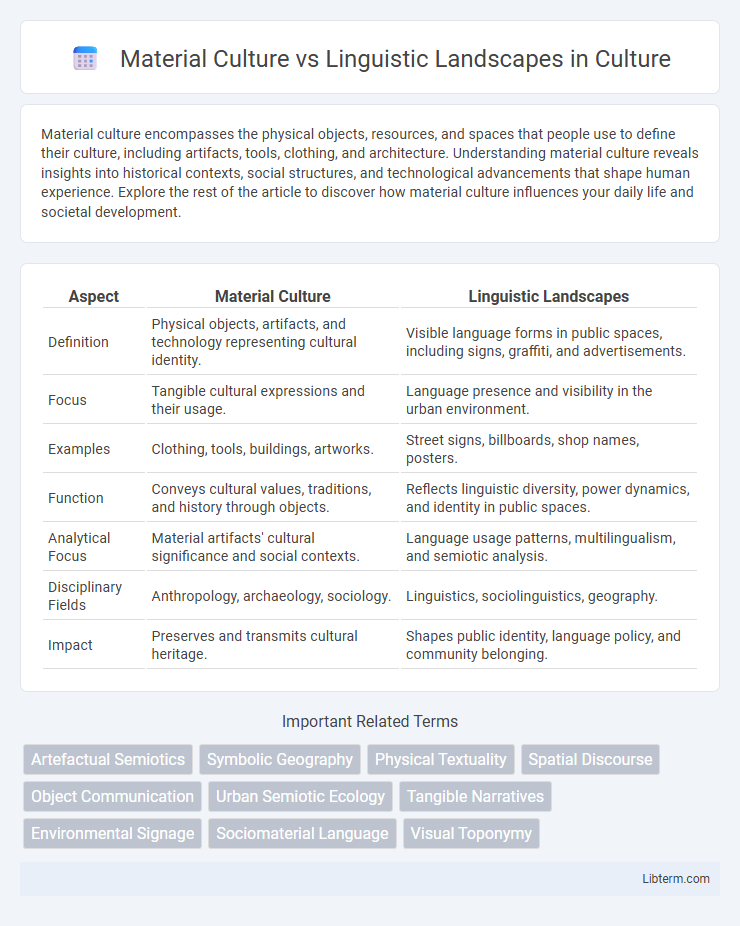Material culture encompasses the physical objects, resources, and spaces that people use to define their culture, including artifacts, tools, clothing, and architecture. Understanding material culture reveals insights into historical contexts, social structures, and technological advancements that shape human experience. Explore the rest of the article to discover how material culture influences your daily life and societal development.
Table of Comparison
| Aspect | Material Culture | Linguistic Landscapes |
|---|---|---|
| Definition | Physical objects, artifacts, and technology representing cultural identity. | Visible language forms in public spaces, including signs, graffiti, and advertisements. |
| Focus | Tangible cultural expressions and their usage. | Language presence and visibility in the urban environment. |
| Examples | Clothing, tools, buildings, artworks. | Street signs, billboards, shop names, posters. |
| Function | Conveys cultural values, traditions, and history through objects. | Reflects linguistic diversity, power dynamics, and identity in public spaces. |
| Analytical Focus | Material artifacts' cultural significance and social contexts. | Language usage patterns, multilingualism, and semiotic analysis. |
| Disciplinary Fields | Anthropology, archaeology, sociology. | Linguistics, sociolinguistics, geography. |
| Impact | Preserves and transmits cultural heritage. | Shapes public identity, language policy, and community belonging. |
Introduction to Material Culture and Linguistic Landscapes
Material culture encompasses the physical objects, artifacts, and spaces created and used by people, reflecting their cultural practices and social identities. Linguistic landscapes refer to the visibility and presence of languages displayed in public and private spaces through signs, advertisements, and inscriptions, revealing patterns of language use and social power dynamics. Both fields analyze how tangible and visual elements communicate cultural meanings and influence community interactions.
Defining Material Culture: Concepts and Examples
Material culture encompasses physical objects, artifacts, and spaces created or modified by humans, reflecting social practices, values, and identities. Examples include tools, clothing, architecture, and art, each serving as tangible evidence of cultural expression and historical context. Understanding material culture provides insights into everyday life and societal structures across different time periods and regions.
Exploring Linguistic Landscapes: An Overview
Linguistic landscapes represent the visible display of languages in public spaces, reflecting social identities, power dynamics, and cultural diversity. They encompass signage, advertisements, graffiti, and other textual materials that reveal linguistic hierarchies and community interactions within urban environments. Analyzing linguistic landscapes provides critical insights into multilingualism, language policy, and the spatial manifestation of language use in everyday life.
Comparative Analysis: Material Culture vs Linguistic Landscapes
Material culture encompasses physical artifacts and tangible objects that convey historical and social meanings, while linguistic landscapes focus on visible language displays in public spaces reflecting sociolinguistic dynamics. Comparative analysis reveals material culture's emphasis on sensory and spatial experiences contrasts with linguistic landscapes' representation of language policies, identity, and communication patterns in multicultural settings. Both domains intersect by illustrating how human expression and cultural identity manifest through objects and language in the environment.
Functions and Roles in Society
Material culture serves as the tangible representation of societal values, beliefs, and history, shaping identity through artifacts, architecture, and technology that facilitate daily living and social interaction. Linguistic landscapes, displayed in public signage, advertisements, and graffiti, function as dynamic markers of linguistic diversity, power relations, and cultural presence within a community. Both material culture and linguistic landscapes play crucial roles in reinforcing social norms, enabling communication, and reflecting the socio-political context of a given society.
Impacts on Identity and Community
Material culture, including artifacts, architecture, and clothing, shapes identity by providing tangible symbols that communities use to express heritage and social values. Linguistic landscapes, composed of public signage and written language in shared spaces, influence communal identity by reflecting linguistic diversity and power dynamics within a community. Together, these elements interact to reinforce belonging, cultural memory, and social cohesion, impacting how individuals and groups perceive their place within society.
Methods of Studying Material Culture
Methods of studying material culture involve analyzing physical artifacts, architecture, and spatial arrangements to understand social practices and cultural meanings. Ethnographic fieldwork, including participant observation and artifact documentation, helps researchers interpret the tangible expressions of human life. Comparative analysis of material objects across time and regions reveals patterns of technological development, trade, and cultural exchange.
Techniques for Analyzing Linguistic Landscapes
Techniques for analyzing linguistic landscapes involve systematic documentation, spatial mapping, and qualitative content analysis of public signage, advertisements, and graffiti to understand language usage patterns in social contexts. Researchers employ photographic surveys, GIS mapping, and socio-linguistic interviews to capture multilingual visibility and language hierarchies in urban environments. Quantitative metrics like language dominance, script diversity, and sign typology provide insights into cultural identity, power dynamics, and language policy effects within material culture.
Intersections and Interactions Between the Two
Material culture and linguistic landscapes intersect through the tangible manifestations of language in public spaces, such as signage, murals, and inscriptions that embody cultural identity and social values. These interactions reveal how language shapes and is shaped by physical artifacts, influencing community cohesion and cultural expression. The dynamic interplay between material objects and linguistic elements highlights the reciprocal relationship between spatial environments and communicative practices.
Future Directions and Research Opportunities
Future directions in studying Material Culture emphasize integrating digital technologies such as 3D modeling and augmented reality to enhance artifact analysis and preservation. Research opportunities in Linguistic Landscapes include exploring multilingual signage in urban spaces to understand social integration and identity construction. Combining both fields offers potential for interdisciplinary studies on how physical objects and language co-create cultural narratives in evolving public environments.
Material Culture Infographic

 libterm.com
libterm.com